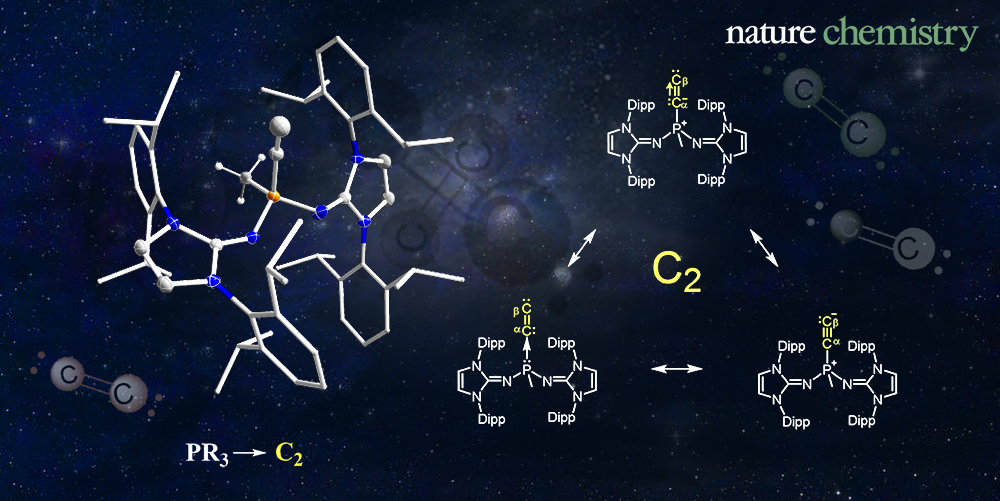Institute of Chemistry, Academia Sinica – Research
全球首例成功合成且分離的單配位基雙原子碳分子
Isolable dicarbon stabilized by a single phosphine ligandNature Chemistry 2021, 13(1), 89-93
Tsz-Fai Leung, Dandan Jiang, Ming-Chun Wu, Dengmengfei Xiao, Wei-Min Ching, Glenn P. A. Yap, Tao Yang, Lili Zhao, Tiow-Gan Ong & Gernot Frenking

Dicarbon(0) C2, the smallest diatomic molecule with a carbon–carbon bond. In contrast to the natural occurrence of F2, O2 and N2 as diatomic species, C2 is too reactive for experimental studies in the condensed phase, which has been only detected at extremely high temperature (> 3500 °C) in the blue flame and in interstellar atmosphere. There have been numerous synthetic attempts to stabilize C2 experimentally with many kinds of chemical ligand strategy. So far, efforts meet deadlock, as bonding situation of the central C2 differ significantly from those of free C2. Thus, the nature of the bond and electronic states in C2 has limited to only theoretical simulations with controversial outcomes and disagreements within the Chemical Science community.
Our recent scientific breakthrough led by Prof. Dr. Tiow-Gan Ong (Research Fellow), Dr. Tsz-Fai Leung (Postdoctoral Research Fellow) and Mr. Ming-Chun Wu (Ph.D. graduate student) at Institute of Chemistry, Academia Sinica successfully presents the first straightforward way to isolated stable C2 molecule at ambient temperature as a R3P→C2 using our special custom-made bulky phosphine ligand bearing super electron-rich imidazolidin-2-iminato groups. This work is manifestation of the most state-of-the-art chemical synthesis ingenuity approach to stabilize C2. This important scientific discovery also provides chemical and electronic insights into long-standing difference of scientific interpretations over nature of C2.
A detail experimental study of R3P→C2 using on single crystal X-ray diffraction analysis has indicated Cα-Cβ bond distance with 1.237(4) Å, which is only marginally shorter than in free C2 (1.2425 Å) and intermediate between typical Csp1-Csp1 triple bonds and unconjugated Csp2-Csp2 double bonds. Through the international collaborative research with outstanding theoretical chemists Prof. Gernot Frenking at Marburg University-Germany and Prof. Lili Zhao at Nanjing Tech University, we deployed the most advanced computational techniques called Energy Decomposition Analysis (EDA) to analyze the electronic states of this unique C2 molecule, which contains P–Cα bond with fragments of C2- and the phosphine+. In addition, our lab also unfolded unprecedented chemical reactivity that the R3P→C2 has two reactive carbene character for intermolecular C–H bond activation. This finding would generate a new paradigm of chemical reactivity in carbon and silicon group.
We anticipate that this isolation of the stable complex of C2 will offer possibilities for further applications in main-group and transition-metal in catalysis as well as new bottom-up synthesis technology and mechanism process for preparing new carbon-type super hybrid materials.
The full article entitled “Isolable dicarbon stabilized by a single phosphine ligand” can be now found at the Nature Chemistry website at https://www.nature.com/articles/s41557-020-00579-w
Media Contact:
Dr. Tiow-Gan Ong, Research Fellow/Professor, Institute of Chemistry, Academia Sinica
Email: tgong@gate.sinica.edu.tw
(Tel) +886-2-5572-8648
自由雙原子碳 (Free C2) 為一個具有碳-碳鍵的最小雙原子分子。相較於自然界中穩定存在的雙原子分子例如氧氣(O2)和氮氣(N2),自由雙原子碳因反應性較大,一般僅能通過燭光中藍色的火焰或是在太空星際中才能夠間接觀察到它的存在。最初化學家對於Free C2 的結構利用理論模擬演算,因此存有不同的論述。多個研究團隊為了探討自由雙原子碳的結構,嘗試使用不同的配位基來穩定自由雙原子碳,然而這些C2化合物則與自然界存在的C2 (簡稱Free C2)在結構上有明顯差異。
中央研究院化學研究所王朝諺研究員所帶領的研究團隊-梁子輝博士和吳銘峻博士研究生,應用專業的化學技術成功合成常溫穩定的單配位基雙原子碳分子R3P→C2,此為全球首例。這突破性的發現不僅闡釋了化學結構和電子組態的關係,也解開長久以來化學界對雙原子碳化合物和 Free C2 之間具爭議性的認知差異。
研究過程中使用單晶X光繞射技術對 R3P→C2 的結構進行分析,並透過與德國馬爾堡大學的理論計算專家Gernot Frenking教授和南京工業大學的Lili Zhao教授之國際合作,採用先進的能量分解分析 (Energy Decomposition Analysis, EDA)的計算技術,更深入探討其獨特的結構特性。此外,R3P→C2在 C2部分的兩個碳原子皆展現了意想不到的反應活性,此發現將有助發展碳同族之新型態化學反應。
此研究成功合成了全球首例常溫穩定的單配位基雙原子碳分子 R3P→C2,後續將延伸於發展相關之過渡金屬或主族金屬錯合物,並應用於催化反應、新型化學品及石墨烯、矽、鍺等相關半導體材料開發之可能性。
本論文 「Isolable dicarbon stabilized by a single phosphine ligand」可於Nature Chemistry 網頁閱讀,論文全文 : https://www.nature.com/articles/s41557-020-00579-w
新聞聯絡人:
王朝諺研究員/博士,中央研究院化學所
Email: tgong@gate.sinica.edu.tw
(Tel) +886-2-5572-8648
